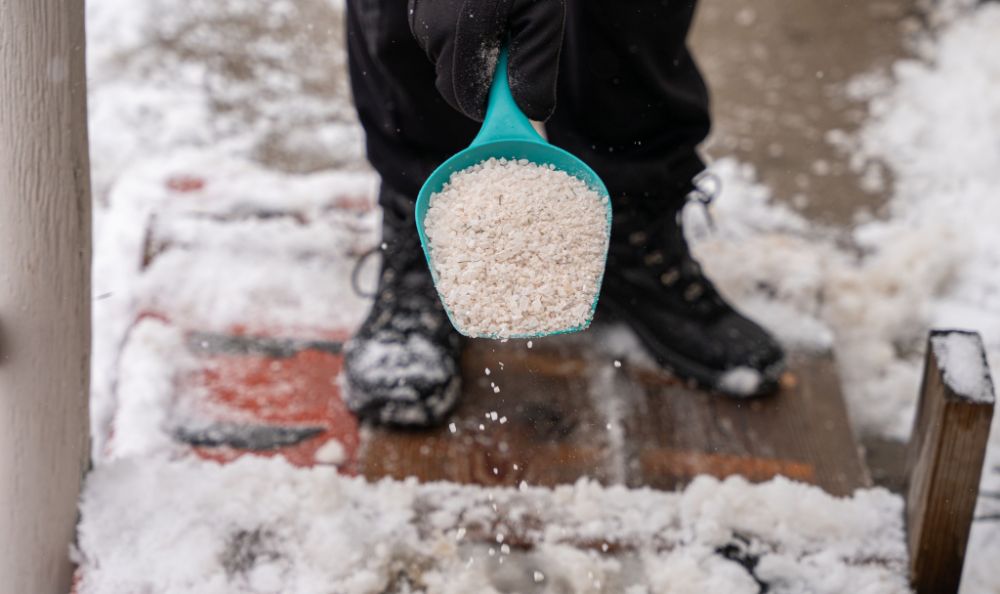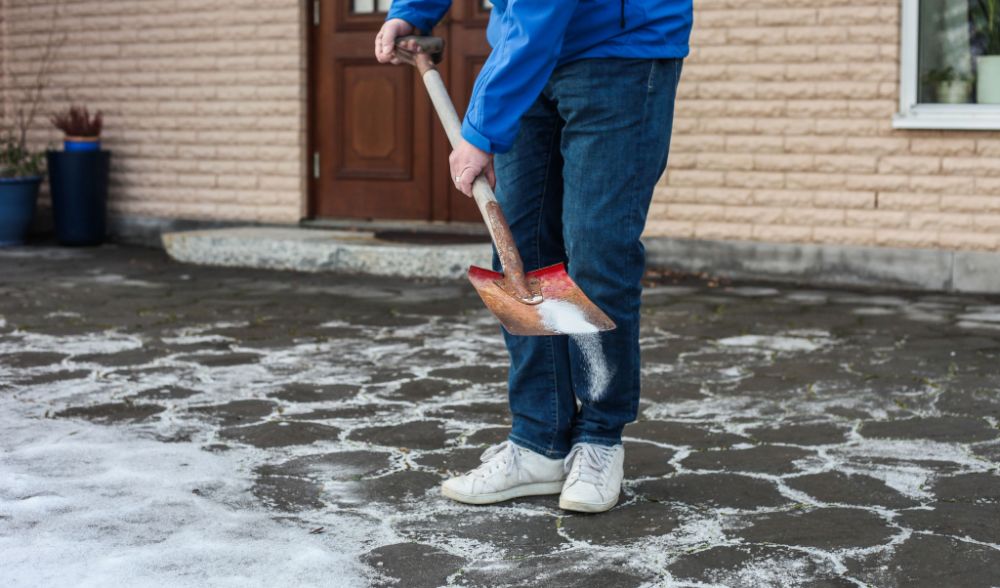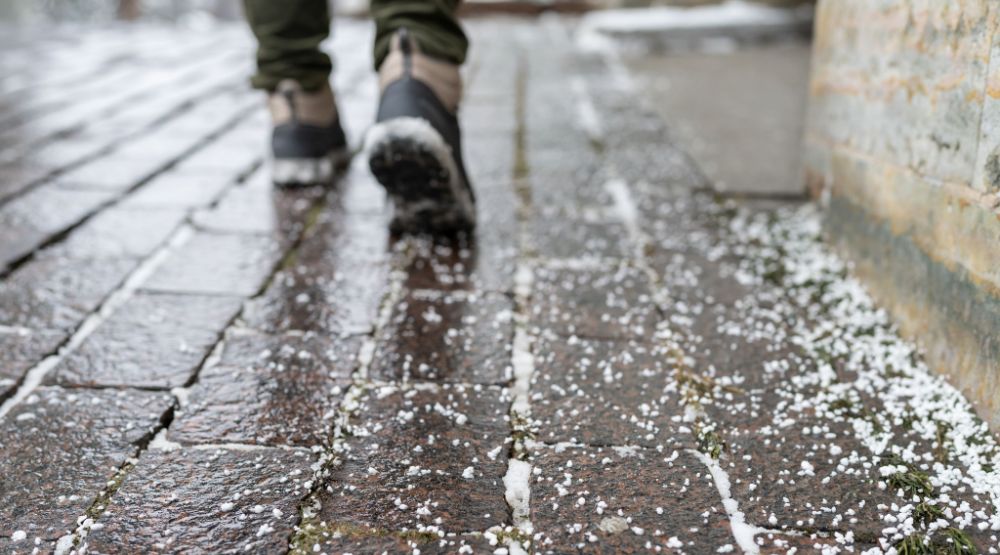During the winter months, snow and ice can cause paths, roads along with driveways to become slippery and frozen. While ice melt is mostly known to help with removing and preventing further buildup of snow and ice – should it be applied before or after the snow comes for the best results?
Ice melt can be applied before snow and will create a brine that can prevent ice from forming and will keep surfaces safe to walk or drive on. However, if temperature levels are expected to drop below the working temperature of the ice melt, or if large quantities of snow or wind are expected then applying ice melt after the snow has been cleared best.
There are some circumstances when applying ice melt before snow is advised and other times when it will be a complete waste and applying it the next day is better. Let’s have a look at these in more detail so you can know exactly when to apply ice melt to your driveway or path.
When Should I Be Applying Ice Melt?

Whether or not you apply ice melt before the snow or afterwards depends on a variety of factors. To work out the best time to apply ice melt need to consider these before making your decision.
Major factors to consider include:
- Amount of snow expected
- Lowest temperatures expected during the snow storm
- Level of wind expected
- Whether or not you need to use the road, driveway or path during the snow storm or afterwards
Apply ice melt before snow can prevent the buildup of ice that makes roads, driveways and paths dangerous in the first place.
If you are expecting fairly moderate levels of snow, low levels of wind and the temperature is not expected to drop below the working temperature of the ice melt then applying ice melt before snow can be a really good solution.
It'll create a brine which will prevent ice from forming and it'll mean your roads, driveways and paths maintain good traction through the snowing period – which can increase safety.
However, there and pros and cons to applying ice melt before snow and sometimes it's best to just wait and apply it after the snow has finished. This allows you to scrape or shovel away surface snow and apply the salt/ice melt directly to the thin layer of ice, which can increase it's effectiveness.
Pros of applying ice melt before it snows:
- Makes snow and ice removal easier
- Prevents snow from hardening and forming dangerous icy layers
- Traction is maintained throughout the snowing period, increasing safety
- Shoveling the slush layer after the ice melt has done its job can help reduce concrete damage and the ice melt can make shoveling the snow/slush easier.
Cons of applying ice melt before it snows:
- You need to be careful during application and ensure you aren’t applying an excessive amount which could cause environmental damage.
- Increased ice melt usage could cause damage to the road, driveway or path. Learn more about how salt deicers damage concrete.
- Doesn’t work if temperatures drop below the working temperature of the ice melt.
- Can be more expensive and wasteful as more salt is needed to melt snow that you would have washed away
- Wind can blow away the ice melt before it is able to work and this can be wasteful and expensive also
Pros of applying ice melt after it snows:
- You can remove bulk surface snow with a shovel and apply ice melt directly to the thin layer of ice
- Helps with maintaining ice melting efficiency as you aren't melting excessive amounts of surface snow
- Works quickly. Most ice melts with melt ice within 20-30 minutes
- Most cost effective as less ice melt is needed
- Less environmental damage
- Less damage to concrete as it is exposed to less ice melt and for a shorter period of time.
Cons of applying ice melt after it snows
- Can be harder to clean and shovel
- You will need to shovel, plow, blow or sweep all of the snow before using the ice melt
- Road, driveway or path can be slippery and unsafe until ice melt is applied
How Do I Know If I Should Be Applying Ice Melt Before or After Snow?

Because sometimes it can be good to apply ice melt before snow and other times it's not recommended it can be difficult to know when to do what.
You should apply ice melt before snow if:
- You will be using the road, driveway or path during the snowing period and need to maintain safe traction at all times
- There will not be excessive amounts of snow that will dilute the ice melt too much (rendering it ineffective)
- Temperatures will not drop below the working temperature for the type of ice melt you're using
- It is not extremely windy (which will blow ice melt away).
If you want to maintain traction at all times then you'll want to apply ice melt before snow as doing so prior to a storm will cause brine to form when snow begins to fall and prevents ice from sticking to the surface.
In the right temperature, your ice melt will also mix with the snow and cause it to melt on your driveway or path, causing ice to never form in the first place.
However, you need to take the type of ice melt and the outside temperature into consideration. The warmer the temperature outside is in comparison to the minimum working temperature of the ice melt, the faster the ice melt will work.
If the outside temperatures are colder than the minimum working temperature of the ice melt, you will need to wait for it to warm up or the ice melt will not work. So on extremely cold evenings sometimes there is no point applying ice melt before the snow as it won't work effectively anyway. It's better to wait until the next day.
Note that if temperatures are going to stay low for a while, it’s best not to use ice melt as it can actually create more ice that you would otherwise have and it can also damage driveways and paths made from concrete.
When the temperature drops too low, you’ll end up with a situation where the ice melt initially melts the snow, but the overly frigid temperature renders the ice melt ineffective, causing it to refreeze and create more ice.
This freeze and thaw cycle will also cause damage to concrete as when ice freezes it places more pressure on the concrete. Using ice melt also causes chemical reactions with concrete which ends up deteriorating it over time.
If you must use an ice melt that can endure extremely cold temperatures, you can consider using Potassium Chloride or Calcium Chloride as they have lower melting points. Calcium chloride ice melt is advised in low temperatures as it has one of the lowest working temperatures out of all the ice melt salts.
You can also consider using sand. While sand does not melt ice, it can be applied to the ice to provide traction and prevent skidding. It also does not damage concrete.
Here are some other ways that you can also go about melting ice from your driveway without using salt.
How To Apply Ice Melt Effectively (Before or After Snow)

Here’s how you’ll go about applying ice melt effectively:
- If there is fresh snow, make sure that you’re shoveling, plowing, blowing or sweeping away the fresh snow before applying your ice melt.
- Make sure that you’re not using too much ice melt as it could damage your sidewalk and also cause environmental damage. Ensure that you’ve also read all of the instructions prior to using your ice melt.
- Choose the right ice melt for you. If you live in frigid temperatures, it would be worthwhile opting for an ice melt that has a lower practical melting temperature. Examples of ice melts that have a lower practical melting temperature include Potassium Chloride and Calcium Chloride.
- Spread the ice melt evenly. You can do this with wheeled or handheld spreaders.
- If possible, make sure that you’ve also got track mats both outside and inside all entrances to prevent ice melt from tracking into your building. If not you run the risk of ice melt damaging your wooden floors and causing dry rot issues in carpets and rugs.
Summary
When it comes to whether you should apply ice melt before or after snow, it’s typically best to apply ice melt before snow as long as temperatures won't drop too low and it's not too windy.
You will, however, need to take temperatures into consideration as certain ice melts won’t work well in overly frigid temperatures.




